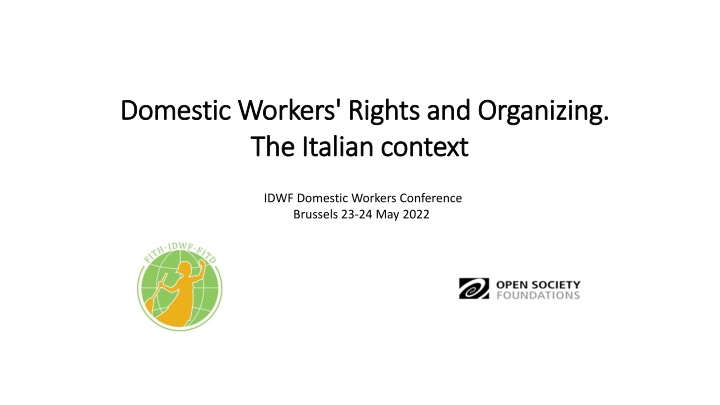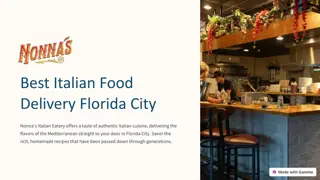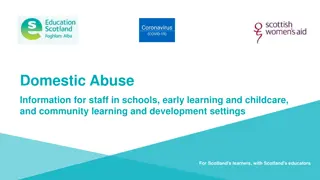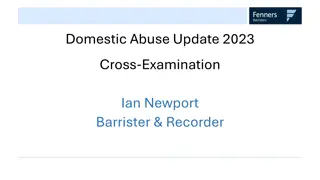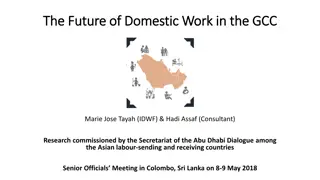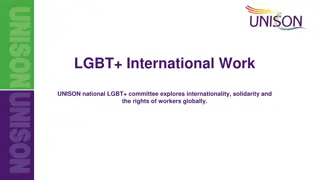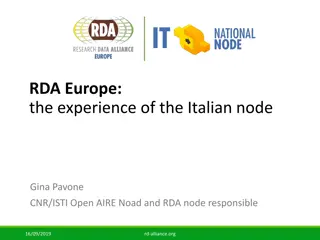Domestic Workers' Rights and Organizing in the Italian Context
The presentation discusses the rights and organizing efforts of domestic workers in Italy, including the impact of ILO Convention 189/2011 and the national collective agreement for domestic work. It delves into statistical data on informality rates, employment trends, and problematic aspects in the sector. The intersectional dimension of domestic workers' organizing is also explored, highlighting the importance of collective action for labor rights, human dignity, and social recognition.
Download Presentation

Please find below an Image/Link to download the presentation.
The content on the website is provided AS IS for your information and personal use only. It may not be sold, licensed, or shared on other websites without obtaining consent from the author.If you encounter any issues during the download, it is possible that the publisher has removed the file from their server.
You are allowed to download the files provided on this website for personal or commercial use, subject to the condition that they are used lawfully. All files are the property of their respective owners.
The content on the website is provided AS IS for your information and personal use only. It may not be sold, licensed, or shared on other websites without obtaining consent from the author.
E N D
Presentation Transcript
Domestic Workers' Rights and Organizing. Domestic Workers' Rights and Organizing. The Italian context The Italian context IDWF Domestic Workers Conference Brussels 23-24 May 2022
Defining domestic work Defining domestic work ILO Convention 189/2011 : equal treatment + non-discrimination Italian Do It Yourself Welfare grounding on family-based care + Increasing participation of women to the national labour force + Aging population Migrant-in-the-family model of care (Bettio, Simonazzi, Villa, 2009) Italy ratified C189 in 2013 (first in Europe) First attempt to regulate the sector: Special Law 339/1958: formal recognition of domestic work / special regime
The national collective agreement for domestic work The national collective agreement for domestic work First contract: 1974 + Last Renewal: October 2020 Signed by DOMINA and FIDALDO on employers side; FILCAMS, FISASCAT, UILTUCS and FEDERCOLF on workers side FIDALDO contract as a reference contract It covers the main important issues (wages, rest, holidays, social security, living conditions for live-in workers, maternity and sick leave ) Special regime: - maternity leave: only maternity leave, no parental leave + contributory restraints. - sick leave: paid by the employer, not by INPS + sick allowance for 15 days max - social security contributions: lower for workers working more than 24 hours per week
Statistical overview Statistical overview Informality rate : 57% 921 000 regular workers / 1,1 million irregular workers Regular employment: 87,6% women 12,4% men 68,8% foreigners 31,2% Italians 52.3% housekeepers 47.5% are caregivers 2013-2020 variation: housekeepers -18,9% / caregivers + 17,7% 34% live-in (foreigners 90%) 66% live-out (Italians 75%) Problematic aspects: Overqualification in domestic work: 17, 7% other sectors: 6,4% Irregular working hours in domestic work: 4,2% other sectors: 14,6 %
Intersectional dimension Intersectional dimension domestic workers organizing represents a form of collective action developed by workers who, being subjected to both economic and symbolic exclusion, fight simultaneously for labour rights, human dignity and social recognition" (Marchetti et al. 2021: 7) Intersection among different social categories (class, race, gender, nationality, age .) structures economic and symbolic exclusion Domestic workers experiences should be framed through intersectional lens : building trust + alliances Employment and working conditions of domestic workers are determined by the intersection of different social categories the trade union is embedded within a particular logic of action (class, race/ethnicity, or social rights) that is associated with a particular strategy (Tapia, Alberti, 2018:5).
Research objectives and methodology Research objectives and methodology Including at least one of the different actors having some active role in supporting and organizing domestic workers. Specific questionnaires concerning the main features of involved organizations FILCAMS CGIL, FISASCAT CISL: trade union federations Rete Nazionale Domestiche -USB; CUB; ADL-COBAS: non-affiliated unions ( sindacati di base , namely unions which are not part of the three main trade union confederations CGIL-CISL-UIL) Movimento Migranti e Rifugiati Napoli : political movement of auto-organised migrants ACLI-COLF: Christianprofessional association of domestic workers Filipino Women s Council: association of Filipino migrant women
Membership Membership Organization Number of members Internal composition Migrant workers Membership fee FILCAMS 15 000 Not Applicable Not Applicable Yes, compulsory FISASCAT Not Applicable -Live-in and Live-out -Housekeepers + caregivers 65% of migrant workers irregular Yes, compulsory (1%) USB 4 800 80% caregivers 2 500 migrants (2 300 irregular) Yes, not compulsory ADL-COBAS 113 -108 women; 5 men -30 live-in; 83 live-out -Housekeepers + caregivers 112 migrants, all regular Yes, not compulsory (0,8%) CUB 607 -435 women ; 172 men -320 live-in ; 185 live-out -110 only housekeepers 80% migrants 260 irregular Yes, not compulsory (1%) ACLI-COLF 700 -housekeepers and caregivers Not Applicable Yes, compulsory (15 /y) MMRN 40 -housekeepers and babysitters -10 live-in; 30 live-out All migrants, all regular or in the process No FWC 18 -all women, mostly live-out All Filipino women No
Stance of organizations and alliances Stance of organizations and alliances Each organization has its networks, but building alliances with different kind of organizations is not common FILCAMS and FISASCAT are both affiliated to the main international trade union federations such as EFFAT, IUF-UITA IUL USB and CUB, as non-affiliated unions, are affiliated with other union federation such as WFTU, Syndacale Solidaires, Confederaci n Nacional del Trabajo ACLI-COLF is within the national catholic network of ACLI MMRN works within the Neapolitan social centre Ex OPG-Je so pazz + member of City Rights United ADL-COBAS: no affiliation, but alliances with anti-racist movements and other radical political movement at the territorial level So, alliances with different actors pursuing the same aims despite existing difference are not common, while affiliation to international union federation reflects differences existing among actors
History, Aims and Objectives History, Aims and Objectives Main trade union federations (FILCAMS, FISASCAT) have a longer history (back to the beginning of the 19th century) + Focus on representing all workers (women and men, Italians and foreigners), in different employment conditions + democratic basis + set general objectives of collective bargaining in the service sector, while promoting bilateral welfare, employability, training, supplementary pensions. Social dialogue and networking are essential Non-affiliated unions born at the end of 1980s against union federations turn to social dialogue, since they prioritize strikes over social dialogue + broad political approach to labour issues: They link together workplace struggles with territorial and social struggles Other organizations have different contingent focus, and they deal with domestic work also because of its intersectional dimension: MMRN is specifically focused on migrant issues, having a strong political comittment FWC focuses on gender and migration issues ACLI-COLF deals specifically with domestic work issues (employment, gender, cultural integration of migrants)
Support activities for domestic workers Support activities for domestic workers
Among basic activities, the importance of training and legal advice is evident to all the organizations Specific activities for migrant workers: free advice through welfare centre (patronati) on labour and welfare issues specific support for 2020 extraordinary amnesty for undocumented migrants cultural activities for integration (not unions) Job search support and psychological counselling are not common among unions, while they are more frequently organized by organizations specifically aiming to strengthen domestic workers as a community
Specific campaigns for domestic workers Specific campaigns for domestic workers Campaigns for social protection, incl. health care 5 Regularization of undocumented migrant workers campaigns 7 General migrants rights campaigns 5 Ratification of C 190 3 Ratification of C 189 3 0 1 2 3 4 5 6 7 8
C189 and C190 promotional campaigns only by trade union federations + FWC Trade union federations are more involved in different campaigns at international and national level Ero Straniero campaign: temporary residence permit for job-seeking 2021 Policy Platform for domestic work: broader approach to domestic work s still open challenges: maternity leave + sick leave + income deductibility + immigration law reform + universal allowance Non-affiliated unions and political movements as MMRN are more focused on highlighting the structural limits of 2020 extraordinary amnesty + extraordinary residence permit for people still waiting for an answer
Main problems in domestic work Main problems in domestic work Labour informality: family-based dimension of Italian welfare + difficult labour inspections + socio-economic undervaluation of this work Migration regime: specific vulnerability of migrant domestic workers, even more if live-in Irregular practices of both for-profit and not-for-profit labour intermediaries - Expand the effectiveness of the national collective contract - Reform the migration regime ( Ero straniero proposal) - Economic support to families - Raising-awareness campaigns - Enhancing labour inspections
Covid Covid- -19 impact 19 impact Two main trajectories for domestic workers during the pandemic: - dismissals for live-out workers - isolation and segregation for live-in workers Government measures: domestic workers defined as essential workers, but invisible Thanks to unions and public opinion: late economic support of 1000 for the months of March and April 2020, only for live-out workers working a certain amount of time. Crucial role of CASSA COLF 2020 extraordinary amnesty: difficult procedure + long bureaucracy + scams . Still limited positive impact
Conclusions Conclusions Different actors deal with domestic work issues from different perspectives (labour issues + migration + gender) The intersectional dimension of domestic work is crucial Intersectional alliances are still limited: different actors do not co-operate Fligstein and McAdam definition of strategic field of action (2012): networking among different actors that, respecting their internal difference, co-operate sharing very specific aims
